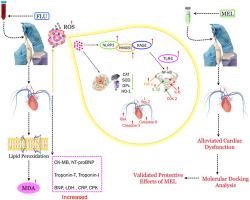Melanoxetin modulates oxidative, inflammatory and apoptotic pathways to confer cardio-protection against flumethrin-induced sub-chronic toxicity
IF 2.4
4区 医学
Q2 PHARMACOLOGY & PHARMACY
引用次数: 0
Abstract
Flumethrin (FLU) is a broad-spectrum pyrethroid that has been evidenced to cause various cardiac impairments. Melanoxetin (MEL) is a natural polyphenolic compound with diverse biological abilities. This research was executed to analyze the recuperative potential of MEL against FLU provoked sub-chronic cardiotoxicity in rats. Thirty-six Sprague Dawley rats were categorized into the control, FLU (5 mg/kg) intoxicated, FLU (5 mg/kg) + MEL (10 mg/kg) therapeutic and MEL (10 mg/kg) alone administered group. Our findings showed that FLU intoxication increased the gene expressions of Toll-like receptor 4 (TLR4), nuclear factor-kappa B (NF-κB), NLRP3, high mobility group box 1 (HMGB1), tumor necrosis factor-α (TNF-α), receptor for advanced glycation end-products (RAGE) interleukin-1β (IL-1β), cyclooxygenase-2 (COX-2) & interleukin-6 (IL-6) while increasing the levels of reactive oxygen species (ROS) and malondialdehyde (MDA). Moreover, the enzymatic activities of glutathione peroxidase (GPx), glutathione reductase (GSR), glutathione S-transferase (GST), superoxide dismutase (SOD), catalase (CAT), heme-oxygenase-1 (HO-1) and glutathione (GSH) were lowered whereas the levels of Troponin I, pro B-type natriuretic peptide (ProBNP), creatine kinase-myocardial band (CK-MB) C-reactive protein, Lactate dehydrogenase (LDH), troponin-T, Brain natriuretic peptide (BNP) and Creatine phosphokinase (CPK) were increased following the FLU intoxication. Furthermore, FLU exposure promoted the levels of Bax, Caspase-9, and Caspase-3 while lowering the levels of Bcl-2. FLU administration abruptly damages the morphology of heart tissues. Nonetheless, MEL therapy excellently ameliorated cardiac toxicity by virtue of its anti-inflammatory, antioxidative and anti-apoptotic potential. Collectively, MEL may serve as a cardioprotective agent in counteracting FLU provoking sub-chronic cardiotoxicity.

黑洛西汀调节氧化、炎症和凋亡途径,赋予心脏保护免受氟氯菊酯诱导的亚慢性毒性
氟甲菊酯(FLU)是一种广谱拟除虫菊酯,已被证明会导致各种心脏损伤。黑色素西汀(MEL)是一种具有多种生物学功能的天然多酚类化合物。本研究旨在分析MEL对流感引起的大鼠亚慢性心脏毒性的恢复潜力。将36只Sprague Dawley大鼠分为对照组、FLU (5 mg/kg)中毒组、FLU (5 mg/kg) + MEL (10 mg/kg)治疗组和MEL (10 mg/kg)单药组。我们的研究结果表明,流感中毒增加了toll样受体4 (TLR4)、核因子κB (NF-κB)、NLRP3、高迁移率组盒1 (HMGB1)、肿瘤坏死因子-α (TNF-α)、晚期糖基化终产物受体(RAGE)、白细胞介素-1β (IL-1β)、环氧化酶-2 (COX-2)和白细胞介素-6 (IL-6)的基因表达,同时增加了活性氧(ROS)和丙二醛(MDA)的水平。谷胱甘肽过氧化物酶(GPx)、谷胱甘肽还原酶(GSR)、谷胱甘肽s转移酶(GST)、超氧化物歧化酶(SOD)、过氧化氢酶(CAT)、血红素加氧酶-1 (HO-1)和谷胱甘肽(GSH)活性降低,肌钙蛋白I、前b型利钠肽(ProBNP)、肌酸激酶-心肌带(CK-MB) c反应蛋白、乳酸脱氢酶(LDH)、肌钙蛋白-t、脑钠肽(BNP)和肌酸磷酸激酶(CPK)在流感中毒后升高。此外,流感暴露提高了Bax、Caspase-9和Caspase-3的水平,同时降低了Bcl-2的水平。注射流感会突然破坏心脏组织的形态。尽管如此,MEL治疗凭借其抗炎、抗氧化和抗凋亡的潜力,出色地改善了心脏毒性。总的来说,MEL可以作为一种心脏保护剂来对抗流感引起的亚慢性心脏毒性。
本文章由计算机程序翻译,如有差异,请以英文原文为准。
求助全文
约1分钟内获得全文
求助全文
来源期刊

Toxicon
医学-毒理学
CiteScore
4.80
自引率
10.70%
发文量
358
审稿时长
68 days
期刊介绍:
Toxicon has an open access mirror Toxicon: X, sharing the same aims and scope, editorial team, submission system and rigorous peer review. An introductory offer Toxicon: X - full waiver of the Open Access fee.
Toxicon''s "aims and scope" are to publish:
-articles containing the results of original research on problems related to toxins derived from animals, plants and microorganisms
-papers on novel findings related to the chemical, pharmacological, toxicological, and immunological properties of natural toxins
-molecular biological studies of toxins and other genes from poisonous and venomous organisms that advance understanding of the role or function of toxins
-clinical observations on poisoning and envenoming where a new therapeutic principle has been proposed or a decidedly superior clinical result has been obtained.
-material on the use of toxins as tools in studying biological processes and material on subjects related to venom and antivenom problems.
-articles on the translational application of toxins, for example as drugs and insecticides
-epidemiological studies on envenoming or poisoning, so long as they highlight a previously unrecognised medical problem or provide insight into the prevention or medical treatment of envenoming or poisoning. Retrospective surveys of hospital records, especially those lacking species identification, will not be considered for publication. Properly designed prospective community-based surveys are strongly encouraged.
-articles describing well-known activities of venoms, such as antibacterial, anticancer, and analgesic activities of arachnid venoms, without any attempt to define the mechanism of action or purify the active component, will not be considered for publication in Toxicon.
-review articles on problems related to toxinology.
To encourage the exchange of ideas, sections of the journal may be devoted to Short Communications, Letters to the Editor and activities of the affiliated societies.
 求助内容:
求助内容: 应助结果提醒方式:
应助结果提醒方式:


